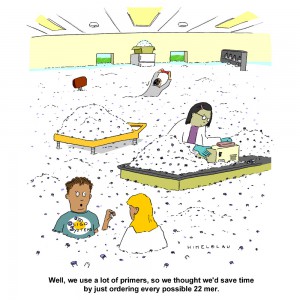 The first time I performed PCR was in 1992. I was finishing my Bachelors in Genetics and had an independent study project in a population genetics laboratory. My task was to try using a new technique, RAPD PCR, to distinguish clonal populations of the sea anemone, Metridium senile. These creatures can reproduce both sexually and asexually, which can make population genetics studies challenging. My professor was looking for a relatively simple method to identify individuals who were genetically identical (i.e., potential clones).
The first time I performed PCR was in 1992. I was finishing my Bachelors in Genetics and had an independent study project in a population genetics laboratory. My task was to try using a new technique, RAPD PCR, to distinguish clonal populations of the sea anemone, Metridium senile. These creatures can reproduce both sexually and asexually, which can make population genetics studies challenging. My professor was looking for a relatively simple method to identify individuals who were genetically identical (i.e., potential clones).
PCR was still in its infancy. No one in my lab had ever tried it before, and the department had one thermal cycler, which was located in a building across the street. We had a paper describing RAPD PCR for population work, so we ordered primers and Taq DNA polymerase and set about grinding up bits of frozen sea anemone to isolate the DNA. [The grinding process had to be done using a mortar and pestle seated in a bath of liquid nitrogen because the tissue had to remain frozen. If it thawed it became a disgusting mass of goo that was useless—but that is a topic for a different blog.] Since I had never done any of the procedures before, my professor and I assembled the first set of reactions together. When we ran our results on a gel, we had all sorts of bands—just what he was hoping to see. Unfortunately, we realized that we had added 10X more Taq DNA polymerase than we should have used. I repeated the amplification with the correct amount of Taq polymerase, and I saw nothing.
At that time, there was not a lot of information available for PCR optimization. I wish that I had had a list like the one below to follow:
Top 10 things you can do to improve your PCR results
10. Modify your reaction buffer composition to adjust pH and salt concentrations.
9. Titrate the amount of DNA polymerase.
8. Add PCR enhancers such as BSA, betaine, DMSO, nonionic detergents, formamide or (NH4)2SO4.
7. Switch to hot-start PCR.
6. Optimize your cycle number and cycling parameters, including denaturation and extension times.
5. Choose your primer sequences wisely.
4. Determine optimal DNA template quantity.
3. Clean up your DNA template to remove PCR inhibitors.
2. Determine the optimal annealing temperature of your PCR template.
1. Titrate the magnesium concentration!
I spent the rest of that semester, trying everything I could think of to optimize my reactions. I ground sea anemones, assembled amplification reactions and ran the resulting amplification products out on agarose gels.
And I assembled an entire notebook of empty gel images.
Are you trying to optimize your PCR amplifications? Or do you have a story of your own about the tricky nature of PCR? Share them in the comments below.
If you are facing your own uncooperative PCR target, this webinar offers more tips and tricks.
Finally, if you are looking for more information regarding PCR set-up, reference the supplementary video below.
Kelly Grooms
Latest posts by Kelly Grooms (see all)
- Discovery of Protein Involved in TDP-43 Cytoplasmic Re-Localization Points to Potential Gene Therapy for ALS and FTD - April 2, 2024
- Dynein Motor Proteins Could Be the Moving Power Behind Cancer Metastasis - February 16, 2024
- Cyanobacteria Identified as Cause of Elephant Mass Mortality Event - January 11, 2024

One thoughtful comment